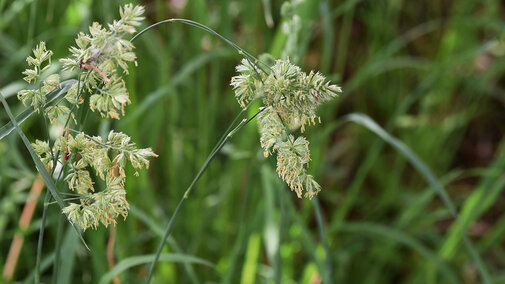Valuing Drought Forage
Fair pricing of drought-stressed forage can be a challenge when harvest costs are higher per ton along with lower yields and reduced energy values due to drought.
Under normal conditions, grain content in a field is about 52% of the total biomass. So, when droughty corn fields are earless, the UNL rule of thumb — multiplying the corn grain value per bushel times 7.65 to equal the forage value per ton — might need adjustment. For example, if the dry matter is only 30% versus the standard 35%, and field grain content is 40% verses normal 52%, then the fair multiplier tonnage price would be five times the grain price instead of 7.65.
An alternative pricing method might be using hay values adjusted for moisture. However, drought many times drives hay prices higher than comparative silage prices. So, the normal rule of thumb — one ton of corn silage substituting for one-third the price of alfalfa hay per ton — may also overvalue droughty forage.
The bottom line is that droughty crops have less TDN (total digestible nutrients) than normal forage, so “rule of thumb pricing” should be slightly adjusted. Actual field sample nutrient content testing (regarding standing forage for grazing, greenchop or silage) is the fairest method for both the buyer and seller.
For example, if we use 72% TDN as normal for corn silage, then a droughty 60% TDN crop adjustment factor would equal 0.83 (60/72) or about 17% less value. Buyers bear the risk of overestimating the value of drought-stressed corn, which often has wetter content and less value than normal corn harvests.
Further value pricing might be improved by using free silage valuing spreadsheets on Nebraska Extension, Iowa State or South Dakota State University websites.
Late Summer Planting of Alfalfa or Grass
Whether it is a new stand of alfalfa or cool-season grasses, late summer is an ideal planting time. These forages planted at this time establish well and usually have much less weed pressure. However, for non-irrigated acres, adequate and consistent moisture will be needed after planting.
Proper seedbed preparation is crucial for late summer plantings. Good seed-to-soil contact and weed control are critical, both when seeding into tilled, prepared seedbeds or into wheat stubble. Conserve soil moisture whenever possible and put extra effort into getting a firm seedbed. For alfalfa, be sure to plant early enough that it has six to eight weeks between emergence and a hard freeze to develop good cold tolerance.
For cool-season grasses, plant at least three or more grasses in a mixture rather than a single species. No single plant is best adapted to all situations, so mixtures help maximize your stand and production potential.
Several grasses can be used, but one of the best is orchardgrass. It regrows fast after proper grazing and grows better in summer than most cool-season grasses. However, it does tend to thin out over time. Smooth brome works well with orchardgrass because it is long lived and can spread into areas as orchardgrass plants die. It also is very palatable, but summer growth is slow. Other good choices include meadow brome, intermediate wheatgrass, tall fescue and festulolium. Legumes such as alfalfa or red or white clover can also be part of the mixture.
With late summer plantings of alfalfa or cool-season grasses, be especially wary of grasshoppers. They sometimes seem to come from nowhere, and they love to eat new seedlings. Spray field margins with insecticides before planting if necessary.
Dealing with High Nitrates
High feed costs mean every forage is important this year, even those that may be high in nitrate due to stress from drought. Doing so requires testing and careful management. Are you prepared?
Some plants are more likely to be high in nitrates than others. Annual grasses like cane, millet, oats and even corn often have elevated nitrate levels. So do certain weeds like pigweed, kochia and lambsquarter. If your hay has lots of these weeds or is an annual grass, be alert to the potential for high nitrates.
To ensure we know what we are up against, testing any feed suspected of being high in nitrates is a good idea. Even when tests come back high, it doesn’t mean these feeds always are toxic, nor does it mean that high-nitrate feeds can’t be used safely.
Nitrates are usually at their highest concentrations towards the bottom of the plant. Avoiding these areas of highest concentration when grazing or haying lower risks.
When grazing, providing plenty of water and alternative feed while introducing animals slowly to high nitrate forages can lower initial risk. Once again, keeping animals from grazing too short will also help.
If haying, test cured bales and mark those high in nitrate. We can then make a plan to feed these bales safely. Diluting the diet with grain or low nitrate forages is most common. Frequent, small meals that slowly increase the amount of nitrate fed helps cattle adapt to high nitrate hay. And again, ensure access to fresh water.
Silage harvest, unlike grazing or hay, has the potential to actually reduce nitrate levels in a feed up to 50%. Proper fermentation is essential for this to happen and to ensure a quality feed, so make sure to watch moisture levels, pack well and cover silage once chopped.
Nitrate concerns are nothing to sneeze at but can be managed safely with the right tools. Keep animals from using lower portions of a plant that have highest concentrations and work them up to high nitrate feeds slowly. Test hay you think may have an issue, especially annual grasses and hay with a high percentage of weeds. If tests come back high, plan to feed safely by dilution or gradually increase the amount of the feed to adapt animals to it. Silage may be the preferred option for those looking to reduce nitrate levels as opposed to managing risk.

